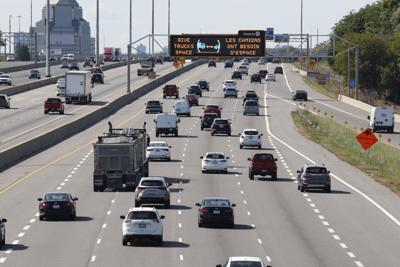Premier Doug Ford’s vision for a 401 tunnel includes three levels: one lane east, one lane west and transit on the bottom.
Ford revealed his concept for a tunnel under Highway 401 ŌĆö a proposal he has floated for nearly a year despite expert concerns┬ĀŌĆö┬Āat an unrelated press conference about the Yonge North subway extension on Thursday.
“We’re going to do a feasibility study,” Ford said, “We are going to study it ŌĆ” make sure it’s safe.”
Ford said the original plan was to have two tunnels, but with “some creativity” he said the plan has been modified to have a single tunnel with three layers that will “serve the people for decades to come.” The tunnel, Ford added, will be 19-and-a-half metres wide, a feat that he said has “never been done in the world.”
A final length for the tunnel hasn’t been decided, though it is expected to stretch for at least 50 kilometres, and could even go past Brampton and Mississauga in the west to Markham and Scarborough in the east, according to the government’s request for proposals (RFP) for a feasibility study.
“I’ll be pushing tulips by the time everyone’s riding this full steam, so it’s a vision and it works, and it’s gonna help our economy and help people get home quicker and get goods to market a lot faster,” Ford said. “It is happening.”
The study on the feasibility of a 401 tunnel is expected to take two years, with an estimated completion date of Feb. 28, 2027, according to the RFP documents.
and ┬Āreported on Tuesday that the Ford government had already done a high-level study of a potential tunnel under the 401 in 2021, through unsolicited proposals from engineering companies. That study was shelved for unknown reasons, according to both outlets.
Ford first floated the idea of tunnelling under the busiest highway in Ontario last fall as a way to combat the GTAŌĆÖs debilitating congestion.
ŌĆ£Let’s get some proper people in there to do a full-fledged study. It can be built,” he said Wednesday. “We have to start these projects across the country, and I’m confident that the federal government will come out with large national infrastructure projects. We need to keep moving.ŌĆØ
Infrastructure and engineering experts, however, have put a damper on the proposal,┬Āestimating costs of anywhere from $250 million to $1.5 billion per kilometre and a timeline of well over a decade. International research consistently says that adding highway lanes will not, long term, alleviate congestion and might make it worse because new road space induces more people to drive it.
Ontario PC Leader Doug Ford said the┬Ātunnel will reduce highway gridlock. Transportation
Some of those experts on Wednesday told the Star that Ford should make public all earlier evaluations of the tunnel idea. Also, the feasibility study the premier said will be done must look at various options to alleviate the acknowledged problem of crippling gridlock┬ĀŌĆö┬Āand not just the expensive underground proposal.
“It is reasonable that one option could be a tunnel but there are other options, including a massive expansion of public transit and imposing road tolls,” said Matti┬ĀSiemiatycki, a geography professor and director of the University of ╬┌č╗┤½├Į’s Infrastructure Institute.
“You start with the current situation and model the impacts of potential solutions because jumping to a preferred solution isn’t best practice,” he said. “We’ve built an international space station so we can build a long tunnel but the question is should we build it, how much will it cost, how long will it take and, importantly, will it actually alleviate the problem at hand.┬Ā
“The likely answer is ‘No, there are better solutions,’ but if we’re doing a study let’s do this properly and see what it says.”
Shoshanna Saxe, a civil engineer and infrastructure expert at U of T, lauded Ford for being realistic in suggesting he’ll be dead before such a massive infrastructure project could be completed and opened to drivers.
But the premier is dead wrong when he suggests a tunnel will provide clear roadways to drivers of the future, she said.
“If we’re going to invest something like $100 billion we should try to reduce congestion, not make it worse after potentially a small positive impact in the early days,” Saxe said. “You will have the same number of people or more getting on and off the highway so you are just moving the pinch points┬ĀŌĆö you cannot solve congestion with highway lanes.”
Prof. Murtaza Haider, executive director of the Cities Institute at the University of Alberta, said Ford’s updated vision of a three-level tunnel with segregated vehicle lanes plus a dedicated transit level is “not unprecedented” and in line with attempts by some Asian cities to battle bumper-to-bumper traffic.
He said the GTA is straining under explosive population growth and new traffic lanes would help thousands of commuters daily but predicted that the study will find a massive cost to achieve Ford’s tunnel vision.
“Tunnelling in Canada has become prohibitively expensive,” Haider said, noting the current Scarborough subway extension is now expected to cost more than $10 billion for roughly five kilometres of underground track.
“A tunnel under Highway 401, which would need to be significantly longer and more complex, would likely carry a far greater price tag and create new bottlenecks,” at entrance and exit points, Haider said.
“Without a credible funding strategy and implementation plan, such proposals risk remaining aspirational rather than actionable.”
The proposal to tunnel under the 401 is part of a package of driver-friendly proposals the Ford government had floated ahead of last February’s provincial election campaign. Those proposals┬Āincluded removing tolls on portions of Highway 407 and removing bike lanes throughout ╬┌č╗┤½├ĮŌĆÖs downtown core, the latter of which was ruled unconstitutional by a Superior Court judge┬Ālast week.
With files from Robert Benzie





























To join the conversation set a first and last name in your user profile.
Sign in or register for free to join the Conversation